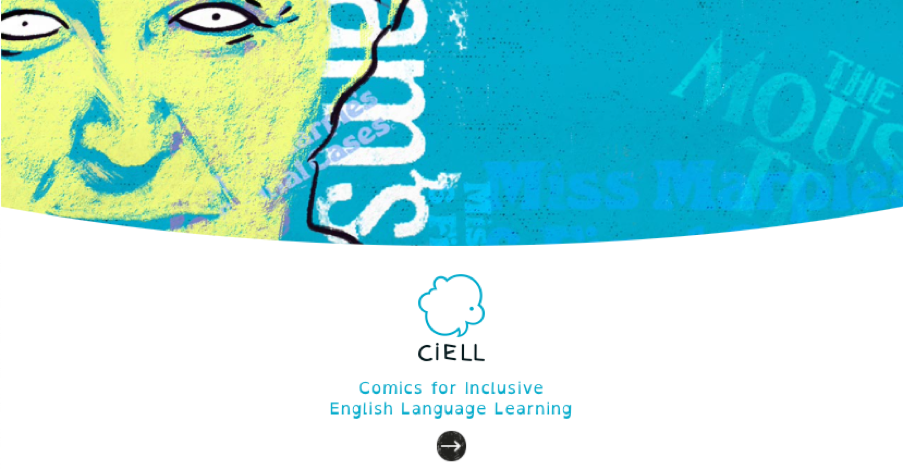Teaching with Comics for Inclusive English Language Learning (CIELL)

Pedagogy embraces methods to teach and help students grow as independent and educated thinkers but not all students learn in the same way so it is vital for educators to create more opportunities for people to learn as part of their daily routines to ensure life-long learning. The CIELL pedagogy is based on mobile learning, visuals such comics and infographics, and inclusion to accommodate people with learning difficulties (e.g dyslexia) and facilitate learning anytime, anywhere. It responds to three fundamental concerns for today’s language teachers.
Firstly, there is increasing diversity as globalization and immigration among other factors pose increasing challenges for the foreign language classroom. Students come from a variety of cultures, ethnicity, economic status, and abilities, therefore, there is a need to adopt more inclusive educational praxis and to make foreign language learning more engaging. “Teachers who are ill prepared to engage with diversity not only fail to take advantage of what it has to offer but can also contribute to climates of discrimination and social injustice” (Banks, 2015 cited in Camillia, Hurwich, Spiegel, and Diamond, 2019, p.3). Thus, CIELL pedagogy offers in and out-of-class activities with visual narratives that could engage multicultural audiences. A multimodal teaching approach has been adopted to facilitate learning though the senses where visuals are combined with audio descriptions of the stories and game-like exercises on writing structure.
Secondly, we are living in the age of digital distraction, in which social media, products and services are fighting to get our attention by using big data to target individuals and the best persuasion experts create adverts. Moreover, the development of digital skills and the need to be always online and available to work, discuss, play, or even learn can diminish attention span and focus. People are frequently distracted by notifications, e-mails, chats, social media and the language that is used in them is heavily dependent on visuals (e.g. Emoji, Instagram). That is to say that, as educators we need to adopt pedagogies that engage students in creative and visually attractive ways. A growing body of research shows that graphic novels are also excellent resources for learning and communication not only for children but also for advanced learners (Themelis & Sime, 2020). European Union funded research projects, the British Council, and the United Nation, to name few, offer open-access narrative graphics that foreign language teachers can use as libraries for reading resources. In brief, comics is a visual language that engage more young students and especially those with dyslexia.
Thirdly, critical literacy is of prime importance for learners as they need to be able to interpret information that they encounter on the internet and seek their own answers in order to cope with the demands of the fast-changing world. The comic artist Nick Sousanis claims: ‘‘I think we want students to go beyond what we can know as the circumstances of the future are ever changing, and so really we want to help them to be able to ask their own questions, to have the confidence to find their own learning’’ (Interview with Nick Sousanis, 2017). The mobile app of the CIELL project aims to provide better access to self-paced learning and also facilitate thinking critically about the United Nation sustainable development goals that are the inspiration for the visual storytelling.
Innovative pedagogies and digital tools provide a potential solution to increasing diversity in foreign language classrooms, the high potential for digital distraction, and the rising need for critical thinking and digital literacy competences development. To this end, we need to re-evaluate the new reality within which students are living, their preferences, and the ways that they are willing to learn. Writing, for example, can be very challenging for learners during exam preparation. To help students perform well, we can change the educational environment and teaching methods and offer alternative ways of learning. Instructional designers have shown that when you love a theme and the text is relevant, learning comes naturally like it does in an exploration game (Kovalik, & McGeehan, 1999). The pedagogy of CIELL provides an opportunity for learners to explore engaging stories about the UN goals with the help of comics and infographics that help them learn about how to structure their writing.
To find out more about the CIELL mobile App and its pedagogy, participate in the conference and workshop for foreign language teachers on 29th October 2020, online, see further information and free registration.
References
Camillia, M., Hurwich, T., Spiegel, A., & Diamond, J. (2019). How do teachers use comics to promote engagement, equity, and diversity in science classrooms? Research in Science Education: Web. DOI https://doi.org/10.1007/s11165-018-9814-8
Kovalik, S. J. & McGeehan, J. R. (1999). Integrated thematic instruction (ITI): From brain research to application. In C. M. Reigeluth (Ed.) Instructional-design theories and models, Volume II. Mahwah, NJ: Lawrence Erlbaum Associates.
Themelis, C., & Sime, J-A. (2020). Comics for inclusive, technology-enhanced language learning. In S. Mavridi, & V. Saumell (Eds.), Digital innovations and research in language learning (pp. 93-114). IATEFL.
Acknowledgements
This research was co-funded by ERASMUS+ Programme of the European Union under Grant 2018-
1-UK01-KA203-048195. The content of this blog is the sole responsibility of the authors and can in no way be taken to reflect the views of the National Agency or the European Commission.
